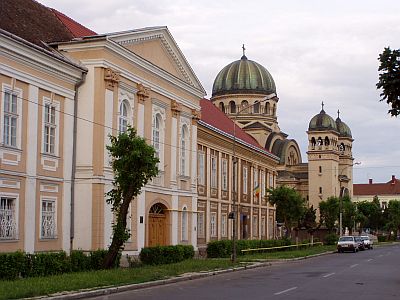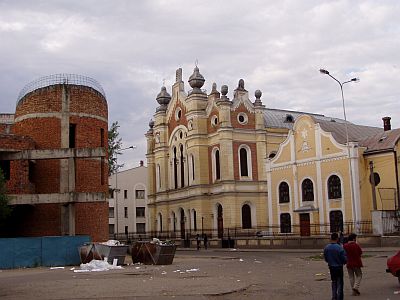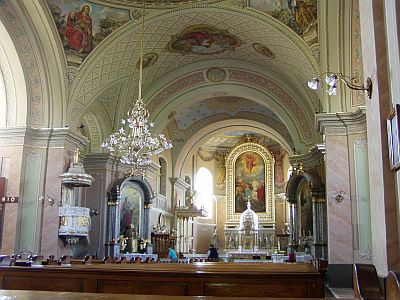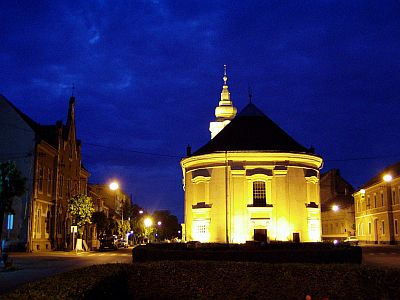|
|
|
|
|
|
 Name: Satu Mare in Romanian. "Satu" means "Village"
and "Mare" means "big". Big village - what a beautiful name for a town! Where do you live? In Big Village! I see...
The Hungarian name seems to derive from the Romanian name: Szatmár, and so does the
German name: Sathmar.
Location:
Satu Mare is located in the north-westernmost corner of Romania and is more than 450 km away from the
capital →Bucharest. The border to the →Ukraine
in the north is around 30 km away, the border to →Hungary in the west around
10 km. The town lies in the middle of a fertile plain. The foot of the mountains is only a couple of kilometres away.
The small river Someş crosses the town.
Population: About 130,000. The district Judetul Satu Mare has
around 395,000 inhabitants. Actually, less than 60% of the citizens are Romanians - 35% are Hungarians, almost 4%
are Germans (Swabians to be exactly), more than 2% are Sinti or Roma. Satu Mare is one of the three larger cities in rural
Maramureş - the others are Baia Mare and
→Sighetu Marmaţiei.
Orientation:
The main part of the city incl. the old town stretches north of the river Someş. The
main train station is around 1 kilometre away from the centre in the east. Right in front of the
station there's the bus terminal and a small park. From the station, the not really attractive main street
Bulevardul Traian leads right to the central square
Piaţa Libertăţii (Freedom Square). The square is quite large and green.
Around the square, you will find several churches, museums and hotels. The district between the central square
and the river in the south is interesting, too: During the reign of Ceauşescu, wide parts of the historic core
had been scrapped and turned into an ugly concrete desert. Among other buildings, it houses the city hall.
Getting there: The train is only useful if you want to go to
→Oradea, Arad, →Cluj-Napoca or Baia Mare.
Twice a day, there's also a direct train to →Budapest.
Getting to the closest bigger city in Hungary (→Debrecen) proves to be difficult.
Surprisingly, neither a train nor a bus connect Satu Mare with Debrecen. All you can do is take a taxi to the
border crossing at Petea (80,000 Lei, € 2) and hitchhike from there.
The only way to get to →Sighetu Marmaţiei in the north
is by bus. The ride takes around 3 hours, the ticket costs 125,000 Lei (€ 3).
Name: Satu Mare in Romanian. "Satu" means "Village"
and "Mare" means "big". Big village - what a beautiful name for a town! Where do you live? In Big Village! I see...
The Hungarian name seems to derive from the Romanian name: Szatmár, and so does the
German name: Sathmar.
Location:
Satu Mare is located in the north-westernmost corner of Romania and is more than 450 km away from the
capital →Bucharest. The border to the →Ukraine
in the north is around 30 km away, the border to →Hungary in the west around
10 km. The town lies in the middle of a fertile plain. The foot of the mountains is only a couple of kilometres away.
The small river Someş crosses the town.
Population: About 130,000. The district Judetul Satu Mare has
around 395,000 inhabitants. Actually, less than 60% of the citizens are Romanians - 35% are Hungarians, almost 4%
are Germans (Swabians to be exactly), more than 2% are Sinti or Roma. Satu Mare is one of the three larger cities in rural
Maramureş - the others are Baia Mare and
→Sighetu Marmaţiei.
Orientation:
The main part of the city incl. the old town stretches north of the river Someş. The
main train station is around 1 kilometre away from the centre in the east. Right in front of the
station there's the bus terminal and a small park. From the station, the not really attractive main street
Bulevardul Traian leads right to the central square
Piaţa Libertăţii (Freedom Square). The square is quite large and green.
Around the square, you will find several churches, museums and hotels. The district between the central square
and the river in the south is interesting, too: During the reign of Ceauşescu, wide parts of the historic core
had been scrapped and turned into an ugly concrete desert. Among other buildings, it houses the city hall.
Getting there: The train is only useful if you want to go to
→Oradea, Arad, →Cluj-Napoca or Baia Mare.
Twice a day, there's also a direct train to →Budapest.
Getting to the closest bigger city in Hungary (→Debrecen) proves to be difficult.
Surprisingly, neither a train nor a bus connect Satu Mare with Debrecen. All you can do is take a taxi to the
border crossing at Petea (80,000 Lei, € 2) and hitchhike from there.
The only way to get to →Sighetu Marmaţiei in the north
is by bus. The ride takes around 3 hours, the ticket costs 125,000 Lei (€ 3).
|
|
|
|
|
|
|
Satu Mare was first mentioned in the 10th century. At that time, it was known as Castrum Zotmar (Zotmar castle).
From the very beginning, many Germans settled in the area. Once there was a fortress in Satu Mare, but it was
completely destroyed during one of the many wars. Ottomans, Hungarians, Habsburgers - the town was attacked and invaded countless times.
From 1699 to 1918 as well as during the Second World War, Satu Mare was occupied by Austria-Hungary resp. Hungary.
However, not many buildings are left from that period.

| |
The large Orthodox Church of the Archangels
|
The town is quite big and relatively modern, not to say pretty uninteresting. Attractions are limited to the central square and the
area around it. On Str. 1 Decembrie 1918 you will find the large
The large Orthodox Church of the Archangels Gabriel & Michael. This church is mainly used by
the Romanian community. Other buildings on the same street show some of the old glamour of Satu Mare.

| |
The old Synagogue of Satu Mare
|
As in many other Romanian cities, Satu Mare had a large Jewish communities. An estimated 13,000 Jews lived in
town, but the majority was deported and murdered in the extermination camps of Nazi Germany. Only one
of the former eight synagogues survived the war - it's the Great Synagogue built in the
year 1920. The synagogue stands on a small street a few metres south of Piaţa Libertăţii. Next to the
synagogue there are some unfinished concrete ruins left from Ceauşescu's brute brave new world
urban development.

| |
Inside the Roman-Catholic Cathedral
|
In the centre, facing the eastern part of Piaţa Libertăţii, you will notice the large domes of the
Roman-Catholic Cathedrale. The church was built around the year 1800, but it was heavily damaged
during the Second World War. The shape is rather unusual - the front and the back dome, connected by the nave, are
equally large, making it look like a huge dumbbell. The dimensions inside are very impressive. This cathedral is mainly used
by the predominantly Catholic Hungarians. And so it doesn't come as a surprise that the service is in Hungarian.

| |
The Hungarian Reformed Church at dusk
|
North of the centre there's the small and nice Piaţa Păcii. Right in the middle of
this square stands the tiny Hungarian Reformed Church - another proof of the strong Hungarian
minority in town. Furthermore you will notice that almost all shops are bilingual. Almost everything is written in Romanian and
Hungarian. Sometimes even in German.
|
|
|
|
|
|
|
Satu Mare is the gateway to rural Maramureş - the north-west corner of Romania. Not far from Satu Mare and
already at the foot of the mountains, there's another big town called Baia Mare (Great Mine).
There, among other things, ore containing gold is exploited. Cyanides are necessary to separate the gold from the dead
rock. This caused a major catastrophe in the year 2000 when a dam burst. Tons of toxic waste were flushed into the river
Tisza (Tisa), leaving a large area along the river in Hungary and Serbia contaminated.
A few kilometres east of Satu Mare around the small town of Negreşti-Oaş you won't
believe your eyes. One luxurious villa after another - it's just incredible. For some reason, this area is booming like no
other place. Many expensive cars with foreign number plates park in front of those houses - must be some kind of investor's paradise!
|
|
|
|
|
|
|
There aren't many choices in Satu Mare. According to the Lonely Planet,
Hotel Sport is the cheapest place to stay and therefore often fully booked. Yes, we can confirm that -
it was fully booked when we showed up.
Hotel Dacia facing the northern side of the central square is large, old and beautiful.
Spacious and clean doubles therefore cost 550,000 Lei (€ 14) per person. Considering the
location and the amenities, it's more than a fair price. And - breakfast is included. Here's the address:
Piaţa Libertăţii 8, Tel.: (061)-714 274, Fax.: 715 774. The hotel seems to be popular with
coach parties, so it might be wise to book ahead.
At Piaţa Păcii, tucked away in a courtyard, there's the Restaurant Mioriţa.
The restaurant serves Romanian and Hungarian cuisine in a rustic atmosphere. Service is great, too, and prices
are reasonable.
|
|
|
|
|
|
|
www.satumare.ro
English web portal of Satu Mare with tons of useful links.
www.satu-mare.net
The offical website of Satu Mare. The English version contains
a lot of information about the town itself, its history etc.
Do you have or do you know a good website about Satu Mare? Don't hesitate, let me know!
After checking it, I would love to add it to the link list.
Please note that commercial websites will be declined. For e-mail link see menu on the left.
|
|
| |